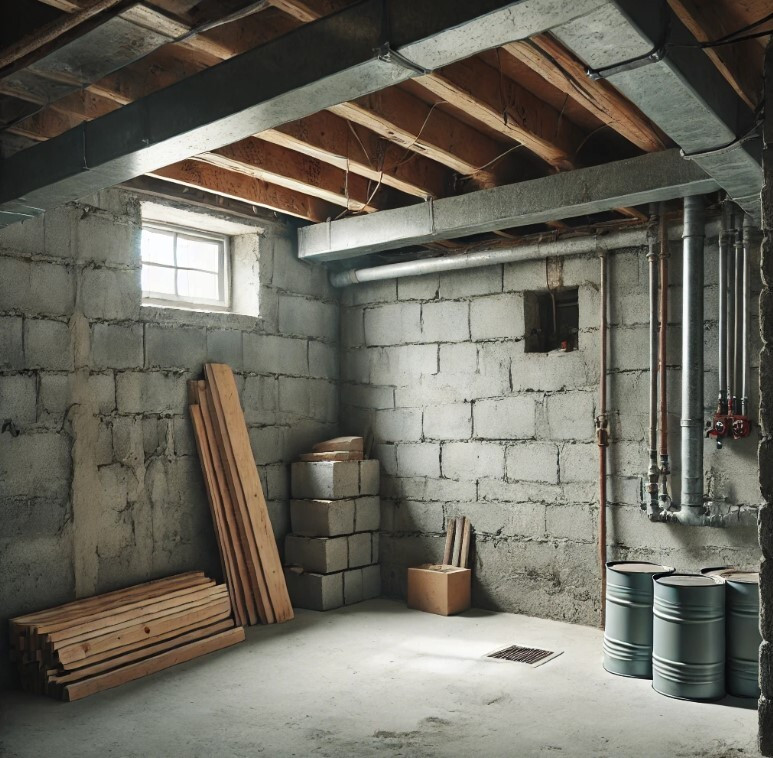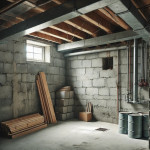Imagine you’ve just finished renovating your basement into a cozy family room, only to be thwarted by an unexpected leak during the next heavy rain. You’re not alone in this predicament. Many homeowners face the challenge of deciding the best method to waterproof their basements.
From interior sealants and exterior drainage systems to complete excavation and waterproofing, there’s a myriad of options available. But which one is the best? The answer isn’t as straightforward as you might think. Let’s explore various waterproofing methods and their effectiveness, to help you make an informed choice for your specific situation.
Key Takeaways
- Basement waterproofing methods are essential for preventing water intrusion and maintaining the structural integrity of a home’s foundation.
- Interior waterproofing techniques focus on managing water already in the basement through sealants, drainage systems, and dehumidifiers.
- Exterior waterproofing solutions aim to prevent water from outside entering the basement through barriers, drainage systems, and foundation sealers.
- Drainage systems for basements, both interior and exterior, play a crucial role in safeguarding the basement from water damage and require professional consultation for correct installation.
Understanding Basement Waterproofing
To fully grasp the concept of basement waterproofing, it’s essential to understand its purpose, methods, and the common problems it can solve. Primarily, the purpose of waterproofing your basement is to prevent water intrusion, which can lead to structural damage, mold growth, and other health hazards. It’s a preventative measure designed to maintain the integrity of your home’s foundation, ensuring it lasts for many years.
There are several methods used in basement waterproofing. These include interior sealants, interior water drainage, exterior waterproofing, and foundation crack injections. Each method has its own unique advantages and is used based on the severity and location of the water problem. You’ll need to choose the most suitable method for your specific situation.
Common problems solved by basement waterproofing include damp walls, standing water, mold and mildew, and musty odors. If you’re experiencing any of these issues in your basement, waterproofing is likely necessary. It’s not just about making your basement dry and usable; it’s about protecting your home’s structure and your health. So, don’t underestimate the importance of understanding and implementing proper basement waterproofing.
Interior Waterproofing Methods
Delving into the realm of interior waterproofing methods, you’ll find they primarily focus on managing water that has already made its way into your basement, rather than preventing it from entering in the first place. These methods are often seen as damage control, but they’re incredibly vital in maintaining the integrity of your house’s structure.
Sealants are one method you can utilize. They’re applied to the walls and floors of your basement to create a water-resistant surface. However, keep in mind that sealants aren’t the ideal solution for severe water infiltration. They’re best used for minor dampness issues.
Another popular method is the installation of interior water drainage systems. They’re designed to work in conjunction with a sump pump. Essentially, these systems collect the water that enters your basement and directs it to a sump pump, which then expels the water outside.
Lastly, you may consider using a dehumidifier. While not a waterproofing method per se, it’s a practical tool to manage the moisture levels in your basement, especially during the humid months. Remember, a dry basement is less prone to mold and mildew growth, preserving your basement’s health and longevity.
Exterior Waterproofing Techniques
Shifting our focus to exterior waterproofing techniques, you’ll find that these methods are primarily designed to prevent water from making its way into your basement from the outside. The most common technique is the application of a waterproofing barrier or membrane. This is typically a thick, rubberized or asphalt-based coating that’s applied to the outer walls of your basement. It creates a solid, impermeable barrier that prevents water from seeping into the walls.
Another popular method is installing a drainage system around the basement. This involves digging a trench around the perimeter of your house and installing a pipe. The pipe is designed to catch any water that’s trying to infiltrate your basement and divert it away from your home. This method can be quite effective, but it’s also labor-intensive and can be costly.
Then there’s the choice of exterior foundation sealers. These sealers are applied to the outside walls of your basement and work by filling in any cracks or holes where water could potentially enter. They’re an excellent preventative measure and can significantly extend the lifespan of your basement walls.
Drainage Solutions for Basements
While exterior waterproofing techniques can be quite effective, it’s also crucial to consider drainage solutions for your basement to further safeguard your space from potential water damage. A well-designed and installed drainage system is your best defense against water seepage, floods, and dampness.
There are two main types of drainage systems that you could implement: interior and exterior. Exterior drainage systems, such as French drains, divert water away from your home before it can penetrate your basement walls. On the other hand, interior drainage methods, like sump pumps, collect water that has already made its way inside and then pump it back out.
You’ll have to decide which one is the best fit for your home based on factors such as the severity of your water issues, your budget, and the design of your home. It’s also advisable to consult with a professional waterproofing company to help you make the right decision and ensure the system is installed correctly. Remember, a well-functioning drainage system isn’t a luxury, but an essential part of keeping your basement dry and your home safe from water damage.
Comparing Waterproofing Costs and Effectiveness
To fully appreciate the value of basement waterproofing, it’s crucial to compare both the costs and effectiveness of different methods. Let’s break down these aspects for three common waterproofing methods: internal water drainage, external water drainage, and waterproofing sealants.
| Method | Average Cost | Effectiveness |
| Internal Water Drainage | $2,000-$6,000 | High |
| External Water Drainage | $8,000-$15,000 | Very High |
| Waterproofing Sealants | $100-$300 | Moderate |
Internal water drainage is a cost-effective method with high effectiveness. It’s designed to manage water that has already entered your basement. However, it doesn’t prevent water from entering.
External water drainage is highly effective, as it keeps water out of your basement altogether. It has the highest cost, but it’s often considered the best long-term solution.
Waterproofing sealants are the most affordable option, but their effectiveness is only moderate. They can help prevent minor moisture, but they’re not designed to handle major leaks.
Frequently Asked Questions
What Are the Potential Health Risks Associated With a Wet Basement?”
A wet basement can pose various health risks to you and your family. The dampness encourages mold and mildew growth, which can lead to respiratory issues, allergic reactions, and asthma attacks.
Furthermore, it can attract pests like rats and insects, potentially spreading diseases. Also, a constantly wet basement creates structural issues, which can cause accidents.
Therefore, it’s vital to keep your basement dry to maintain a healthy, safe home environment.
How Long Does It Take to Waterproof a Basement?”
The time to waterproof your basement depends on several factors. If you’re using a sealant or coating, it can be done in a day or two.
However, if you’re installing a sump pump or drain system, it could take up to a week.
Always remember, quality work may take time, but it’s crucial to prevent future water damage.
It’s best to consult a professional for an accurate timeline based on your specific needs.
Can I Waterproof My Basement by Myself or Do I Need Professional Help?”
You can indeed waterproof your basement yourself, but remember, ‘a stitch in time saves nine.’
While DIY methods might seem cost-effective initially, they may not provide a long-term solution. Professionals have the experience and tools to do a thorough job, addressing not just visible issues, but also underlying problems.
If you’re not confident in your abilities, it’s better to hire a professional to ensure your basement stays dry and safe.
How Often Should Basement Waterproofing Be Maintained or Checked?”
You should check your basement waterproofing system regularly.
It’s advisable to inspect it at least once a year or after severe weather conditions.
If you’re seeing signs of water damage, like dampness or mold, it’s time for a more thorough check.
Regular maintenance can prevent costly repairs in the future.
Does Home Insurance Typically Cover the Costs of Basement Waterproofing?”
Typically, home insurance doesn’t cover the costs of basement waterproofing. It’s seen as a preventative measure, not a repair. It’s your responsibility to keep your home in good condition, and that includes preventing water damage.
However, always check your policy specifics. In some rare cases, if water damage caused by a covered peril leads to the need for waterproofing, you might be covered.
Always remember, it’s better to ask than assume.
Conclusion
In essence, waterproofing your basement isn’t just about slapping on a coat of paint and calling it a day. No, it’s a grand battle, an epic confrontation with the elements themselves.
You’re not just protecting your property, you’re defending your castle! So whether you choose interior methods, exterior techniques, or trusty drainage solutions, know this: the best method is the one that best suits your fortress.
So choose wisely, and let the battle commence!



